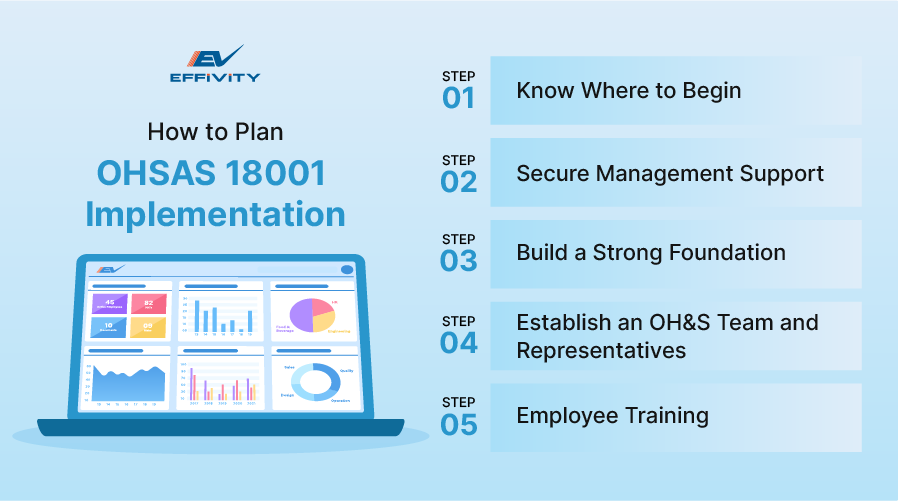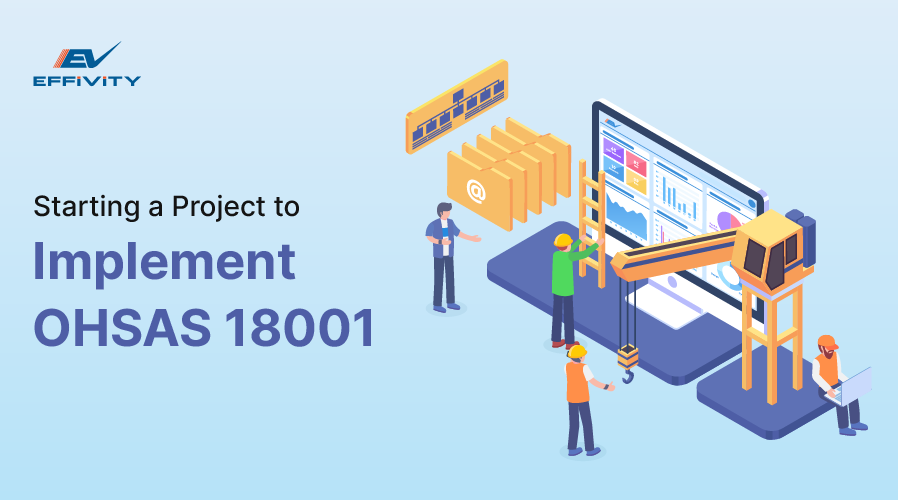A safe workplace is a happy, productive, and efficient workplace. While every organization is vulnerable to certain risks and occupational hazards, a proactive approach can help mitigate risks and demonstrate a strong commitment towards employee health and safety.
This is where implementing the OHSAS 18001 standard for Occupational Health and Safety Management Systems (OHSMS) is a strategic move for organizations. However, using the requirements of OHSAS 18001 to implement an OH&S system demands meticulous planning and execution.
It requires you to take various steps to implement the management system correctly, possibly with the help of health and safety management software, to save time and costs ultimately.

1. Know Where to Begin
A gap analysis is a good place to start to understand where your organization stands in terms of health and safety preparedness and what the OHSAS 18001 requires. This analysis will highlight areas that need improvement and serve as a foundation for developing an effective implementation plan.
Not to forget, it will help you avoid any surprises or unexpected challenges in the middle of the implementation project.
During the gap analysis, it's essential to review existing policies, procedures, and practices. This process might involve interviewing employees, reviewing incident reports, and examining current safety measures. The outcome of the gap analysis will inform the project team about the specific changes and improvements required to meet the standard's criteria.
Since implementing OHSAS 18001 can look different for an organization, make your system company-specific by addressing the health and safety activities and the processes unique to the company. Otherwise, the system won't be successful in the long term.
2. Secure Management Support
The success of the OHSAS 18001 implementation project hinges on the commitment and involvement of top management. Without clear leadership support, the project will likely face resistance or lack the necessary resources.
In fact, if you did manage to implement an OHSAS 18001 system without management support, it becomes difficult to maintain a system afterward without their support. Management must understand the importance of OHSAS 18001 and be willing to allocate time, personnel, and financial resources to the project.
Their commitment should be evident through regular communication and involvement in the project planning and implementation.
3. Build a Strong Foundation
For a solid OHSAS management system, you need a solid foundation, which starts with the implementation of these four elements-
A. Policy
Start by developing and formalizing an occupational health and safety policy that aligns with OHSAS 18001 requirements. The top management can use this to determine the direction the company wants to take to meet OHSAS requirements.
B. Legal requirements
Before you can achieve compliance with OHSAS 18001 legislation, you first have to recognize and understand all legal requirements applicable to your company or industry. Only then will OHSAS implementation be successful.
C. Hazards
What are the existing or potential issues in your company processes that might cause health and safety problems? Understanding these will form the basis of OH&SMS processes.
D. Objectives, programs, and targets
Your OHSAS 18001 system will be successful only with efforts to drive continuous improvement. You must set achievable objectives, targets, and programs to measure your progress and determine improvement in the health and safety processes in the organization.
4. Establish an OH&S Team and Representatives
A dedicated project team is essential for driving the implementation of OHSAS 18001. The team should consist of individuals who deeply understand the organization's operations, safety procedures, and the standard itself. Typically, this team includes representatives from different departments and job roles.
Moreover, depending on the requirements and structure of your company, you can also identify a top manager as the OHSAS representative who will be responsible for the functioning and monitoring of the health and safety management system.
The representative and project team can be responsible for developing a detailed implementation plan, ensuring that the necessary resources are available, addressing key challenges, and coordinating with relevant stakeholders. Besides, if you choose the right person for the job, it can also improve management support and drive improvement.
5. Employee Training
For OHSAS 18001 to be effective, employees must be aware of and committed to the new health and safety standards. Comprehensive training programs should be conducted to educate employees about the new policies, procedures, and their roles in maintaining a safe workplace.
Involving employees in the implementation process can also increase buy-in and ensure the new system is practical and effective. Employees should be encouraged to provide feedback on existing practices and suggest improvements, fostering a safety and continuous improvement culture.
With This Foundation, You Will Have a Better Chance to Succeed
If you plan these five steps properly, it will be easier for you to identify any potential problems in the implementation before they are too big and challenging to fix.
With the groundwork laid, you can start implementing the OHSAS 18001 system across the organization. This phase involves putting the new policies, procedures, and controls into practice.
During implementation, it's important to maintain open lines of communication. Regular updates should be provided to employees, and any concerns or challenges should be addressed swiftly. Monitoring the system's performance in the early stages can help identify any areas that need further refinement.
The Road Ahead
Once the OHSAS 18001 system is in place, conducting an internal audit can help assess the effectiveness of the implementation and identify any non-conformities or areas for improvement.
Also, management should formally review the system to evaluate its effectiveness and decide on any necessary corrective actions.
Starting a project to implement OHSAS 18001 is a significant undertaking that requires careful planning, management commitment, and employee involvement. By following the steps outlined above, organizations can successfully identify any challenges impacting the implementation process and address them promptly to reap the benefits of a safer and more compliant workplace.






























